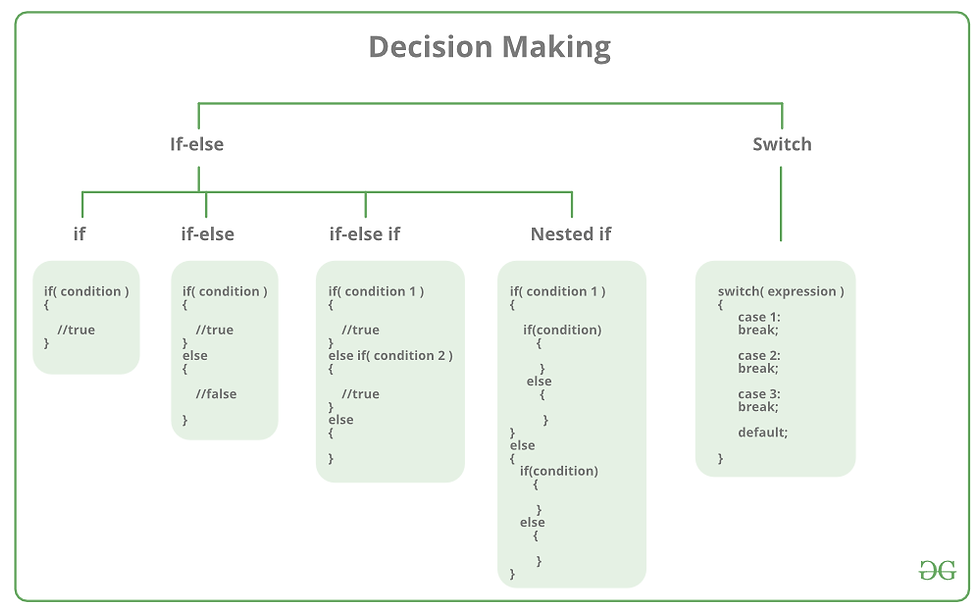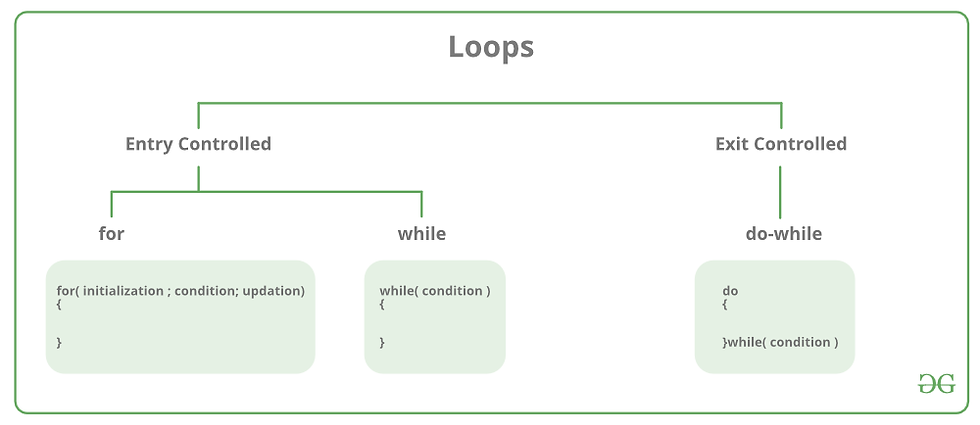Branching and Loop Statements
- Apurba Paul
- Apr 14, 2020
- 7 min read
Decision Making in C / C++ (if , if..else, Nested if, if-else-if )
There come situations in real life when we need to make some decisions and based on these decisions, we decide what should we do next. Similar situations arise in programming also where we need to make some decisions and based on these decisions we will execute the next block of code. For example, in C if x occurs then execute y else execute z. There can also be multiple conditions like in C if x occurs then execute p, else if condition y occurs execute q, else execute r. This condition of C else-if is one of the many ways of importing multiple conditions

if statement in C/C++
if statement is the most simple decision making statement. It is used to decide whether a certain statement or block of statements will be executed or not i.e if a certain condition is true then a block of statement is executed otherwise not. Syntax:
if(condition)
{
// Statements to execute if
// condition is true
}
Here, condition after evaluation will be either true or false. C if statement accepts boolean values – if the value is true then it will execute the block of statements below it otherwise not. If we do not provide the curly braces ‘{‘ and ‘}’ after if(condition) then by default if statement will consider the first immediately below statement to be inside its block. Example:
if(condition)
statement1;
statement2;
// Here if the condition is true, if block
// will consider only statement1 to be inside
// its block.
Flowchart

#include <stdio.h>
int main() {
int i = 10;
if (i > 15)
{
printf("10 is less than 15");
}
printf("I am Not in if");
}
if-else in C/C++
The if statement alone tells us that if a condition is true it will execute a block of statements and if the condition is false it won’t. But what if we want to do something else if the condition is false. Here comes the C else statement. We can use the else statement with if statement to execute a block of code when the condition is false. Syntax:
if (condition)
{
// Executes this block if
// condition is true
}
else
{
// Executes this block if
// condition is false
}
Flowchart:

#include <stdio.h>
int main() {
int i = 20;
if (i < 15)
printf("i is smaller than 15");
else
printf("i is greater than 15");
return 0;
}
nested-if in C/C++
A nested if in C is an if statement that is the target of another if statement. Nested if statements means an if statement inside another if statement. Yes, both C and C++ allows us to nested if statements within if statements, i.e, we can place an if statement inside another if statement. Syntax:
if (condition1)
{
// Executes when condition1 is true
if (condition2)
{
// Executes when condition2 is true
}
}
Flowchart

#include <stdio.h>
int main() {
int i = 10;
if (i == 10)
{
// First if statement
if (i < 15)
printf("i is smaller than 15\n");
// Nested - if statement
// Will only be executed if statement above
// is true
if (i < 12)
printf("i is smaller than 12 too\n");
else
printf("i is greater than 15");
}
return 0;
}
if-else-if ladder in C/C++
Here, a user can decide among multiple options. The C if statements are executed from the top down. As soon as one of the conditions controlling the if is true, the statement associated with that if is executed, and the rest of the C else-if ladder is bypassed. If none of the conditions are true, then the final else statement will be executed. Syntax:
if (condition)
statement;
else if (condition)
statement;
.
.
else
statement;

#include <stdio.h>
int main() {
int i = 20;
if (i == 10)
printf("i is 10");
else if (i == 15)
printf("i is 15");
else if (i == 20)
printf("i is 20");
else
printf("i is not present");
}
Jump Statements in C/C++
These statements are used in C orC++ for unconditional flow of control through out the funtions in a program. They support four type of jump statements:
C break: This loop control statement is used to terminate the loop. As soon as the break statement is encountered from within a loop, the loop iterations stops there and control returns from the loop immediately to the first statement after the loop. Syntax:break; Basically break statements are used in the situations when we are not sure about the actual number of iterations for the loop or we want to terminate the loop based on some condition.

#include <stdio.h>
void findElement(int arr[], int size, int key)
{
// loop to traverse array and search for key
for (int i = 0; i < size; i++) {
if (arr[i] == key) {
printf("Element found at position: %d", (i + 1));
break;
}
}
}
int main() {
int arr[] = { 1, 2, 3, 4, 5, 6 };
// no of elements
int n = 6;
// key to be searched
int key = 3;
// Calling function to find the key
findElement(arr, n, key);
return 0;
}
C continue:This loop control statement is just like thebreak statement. Thecontinuestatement is opposite to that of breakstatement, instead of terminating the loop, it forces to execute the next iteration of the loop.
As the name suggest the continue statement forces the loop to continue or execute the next iteration. When the continue statement is executed in the loop, the code inside the loop following the continue statement will be skipped and next iteration of the loop will begin.
Syntax:
continue;

Loops in C and C++
Loops in programming come into use when we need to repeatedly execute a block of statements. For example: Suppose we want to print “Hello World” 10 times. This can be done in two ways as shown below: Iterative Method An iterative method to do this is to write the printf() statement 10 times.
// C program to illustrate need of loops
#include <stdio.h>
int main()
{
printf( "Hello World\n");
printf( "Hello World\n");
printf( "Hello World\n");
printf( "Hello World\n");
printf( "Hello World\n");
printf( "Hello World\n");
printf( "Hello World\n");
printf( "Hello World\n");
printf( "Hello World\n");
printf( "Hello World\n");
return 0;
}
Using Loops
In Loop, the statement needs to be written only once and the loop will be executed 10 times as shown below. In computer programming, a loop is a sequence of instructions that is repeated until a certain condition is reached.
An operation is done, such as getting an item of data and changing it, and then some condition is checked such as whether a counter has reached a prescribed number.
Counter not Reached: If the counter has not reached the desired number, the next instruction in the sequence returns to the first instruction in the sequence and repeat it.
Counter reached: If the condition has been reached, the next instruction “falls through” to the next sequential instruction or branches outside the loop.
There are mainly two types of loops:
Entry Controlled loops: In this type of loops the test condition is tested before entering the loop body. For Loop and While Loop are entry controlled loops.
Exit Controlled Loops: In this type of loops the test condition is tested or evaluated at the end of loop body. Therefore, the loop body will execute atleast once, irrespective of whether the test condition is true or false. do – while loop is exit controlled loop.

for Loop
A for loop is a repetition control structure which allows us to write a loop that is executed a specific number of times. The loop enables us to perform n number of steps together in one line. Syntax:
for (initialization expr; test expr; update expr)
{
// body of the loop
// statements we want to execute
}
In for loop, a loop variable is used to control the loop. First initialize this loop variable to some value, then check whether this variable is less than or greater than counter value. If statement is true, then loop body is executed and loop variable gets updated . Steps are repeated till exit condition comes.
Initialization Expression: In this expression we have to initialize the loop counter to some value. for example: int i=1;
Test Expression: In this expression we have to test the condition. If the condition evaluates to true then we will execute the body of loop and go to update expression otherwise we will exit from the for loop. For example: i <= 10;
Update Expression: After executing loop body this expression increments/decrements the loop variable by some value. for example: i++;
Equivalent flow diagram for loop :

#include <stdio.h>
int main()
{
int i=0;
for (i = 1; i <= 10; i++)
{
printf( "Hello World\n");
}
return 0;
}
While Loop
While studying for loop we have seen that the number of iterations is known beforehand, i.e. the number of times the loop body is needed to be executed is known to us. while loops are used in situations where we do not know the exact number of iterations of loop beforehand. The loop execution is terminated on the basis of test condition.
Syntax: We have already stated that a loop is mainly consisted of three statements – initialization expression, test expression, update expression. The syntax of the three loops – For, while and do while mainly differs on the placement of these three statements.
initialization expression;
while (test_expression)
{
// statements
update_expression;
}
Flow Diagram:

#include <stdio.h>
int main()
{
// initialization expression
int i = 1;
// test expression
while (i < 6)
{
printf( "Hello World\n");
// update expression
i++;
}
return 0;
}
do while loop
In do while loops also the loop execution is terminated on the basis of test condition. The main difference between do while loop and while loop is in do while loop the condition is tested at the end of loop body, i.e do while loop is exit controlled whereas the other two loops are entry controlled loops. Note: In do while loop the loop body will execute at least once irrespective of test condition.
Syntax:
initialization expression;
do
{
// statements
update_expression;
} while (test_expression);
Note: Notice the semi – colon(“;”) in the end of loop.
Flow Diagram:

#include <stdio.h>
int main()
{
int i = 2; // Initialization expression
do
{
// loop body
printf( "Hello World\n");
// update expression
i++;
} while (i < 1); // test expression
return 0;
}
What about an Infinite Loop?
An infinite loop (sometimes called an endless loop ) is a piece of coding that lacks a functional exit so that it repeats indefinitely. An infinite loop occurs when a condition always evaluates to true. Usually, this is an error.
#include <stdio.h>
int main ()
{
int i;
// This is an infinite for loop as the condition
// expression is blank
for ( ; ; )
{
printf("This loop will run forever.\n");
}
// This is an infinite for loop as the condition
// given in while loop will keep repeating infinitely
/*
while (i != 0)
{
i-- ;
printf( "This loop will run forever.\n");
}
*/
// This is an infinite for loop as the condition
// given in while loop is "true"
/*
while (true)
{
printf( "This loop will run forever.\n");
}
*/
}
Video Link



Comments